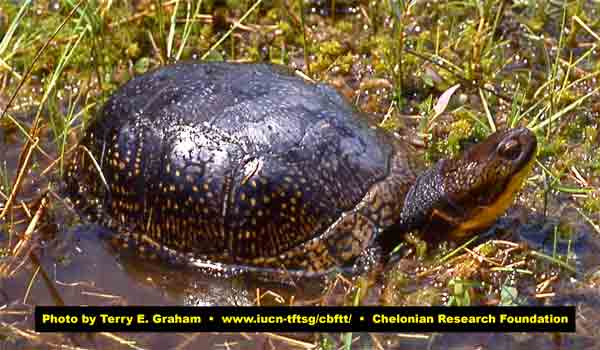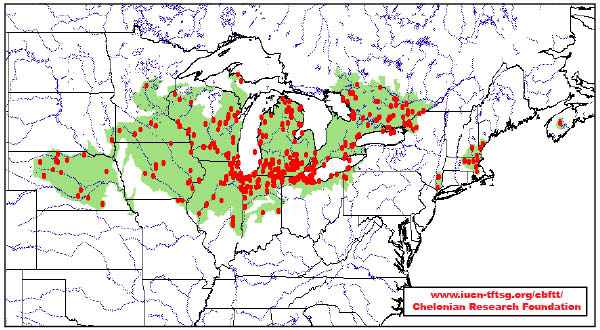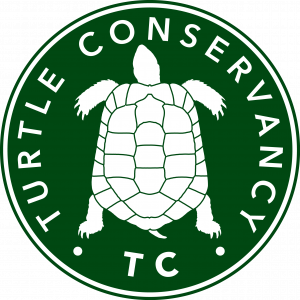Emydoidea blandingii, 015
Emydoidea blandingii (Holbrook 1838) –
Blanding’s Turtle
Justin D. Congdon1,2, Terry E. Graham3, Tom B. Herman4,
Jeffrey W. Lang5, Michael J. Pappas6, and Bruce J. Brecke7
1Bar Boot Ranch, Box 1128, Douglas, Arizona 85608 USA [[email protected]];
2Savannah River Ecology Laboratory, Drawer E, Aiken, South Carolina 29802 USA;
3Department of Biology, Worcester State College, Worcester, Massachusetts 01602 USA [[email protected]];
4Acadia University, Wolfville, Nova Scotia, B4P2R6 Canada [[email protected]];
51385 Brompton St, St. Paul, Minnesota 55108 USA [[email protected]];
6Michaels Restaurant, 15 South Broadway, Rochester, Minnesota 55904 USA [[email protected]];
722675 Co. Blvd. 18 No. 58-A, Welch, Minnesota 55089 USA [[email protected]]
Summary. – In Canada and the United States, the Blanding’s turtle, Emydoidea blandingii (Family Emydidae), is officially designated as endangered or threatened in several provinces and a number of states. In many areas, it has become a “poster species” for attracting public interest in issues common to conservation of freshwater turtles in general. Over the past three decades, knowledge of Blanding’s turtle biology and ecology has increased dramatically, and among species with conservation concerns, it now ranks as one of the best known turtle species throughout much of its range. Blanding’s turtles seldom occur in dense populations such as those of sympatric painted turtles, but two large populations exist in southeastern Minnesota, and in north-central Nebraska. Individuals delay maturity from 14–21 yrs, and can attain ages greater than 75 yrs and still reproduce successfully. Most populations of Blanding’s turtles are threatened by collecting, road mortality, and the reduction and degradation of both aquatic and terrestrial portions of their core habitats. Adults of both sexes make extensive forays onto land to visit temporary wetlands, and adult females move overland on pre-nesting movements and to nest; both activities exposes adults to increased risk of mortality associated with roads, farm machinery, and terrestrial predators. Proposed conservation measures include: 1) methods to reduce road mortality (e.g., fencing and road passages); 2) elimination of commercial collecting; 3) protection of large resident wetlands and smaller ephemeral wetlands; 4) protection and management of adjacent terrestrial areas used for nesting and as corridors for movements among wetlands; 5) research on risks associated with the timing and duration of terrestrial movements of both sexes; and 6) where necessary, removal of nest predators. More extensive regional information can be found in Herman et al. (2003), COSEWIC (2005), and Congdon and Keinath (2006).
Distribution. – Canada, USA. Distributed disjunctly from southeastern Ontario, adjacent Quebec, and southern Nova Scotia, south into New England, and west through the Great Lakes to western Nebraska, Iowa, and extreme northeastern Missouri.
Synonymy. – Testudo flava Lacépède 1788 (name suppressed), Testudo meleagris Shaw 1793 (name suppressed), Lutremys meleagris
, Emys meleagris, Cistuda blandingii Holbrook 1838, Cistudo blandingii, Emys blandingii, Emydoidea blandingii, Neoemys blandingii, Emys twentei Taylor 1943.
Subspecies. – None recognized, but three separate evolutionarily significant units have been identified: 1) the main populations west of the Appalachian Mountains, 2) the disjunct populations east of the Appalachians in southern New York and New England, and 3) the highly disjunct eastern population in southern Nova Scotia.
Status
. – IUCN 2007 Red List: Near Threatened (LR/nt) (assessed 1996, needs updating); CITES: Not Listed; US ESA: Category 2 (Candidate for Listing); Canada Species at Risk Act: Endangered (Nova Scotia), Threatened (Great Lakes / St. Lawrence).
Citation:
Congdon, J.D., Graham, T.E., Herman, T.B., Lang, J.W., Pappas, M.J., and Brecke, B.J. 2008. Emydoidea blandingii (Holbrook 1838) – Blanding’s turtle. In: Rhodin, A.G.J., Pritchard, P.C.H., van Dijk, P.P., Saumure, R.A., Buhlmann, K.A., and Iverson, J.B. (Eds.). Conservation Biology of Freshwater Turtles and Tortoises: A Compilation Project of the IUCN/SSC Tortoise and Freshwater Turtle Specialist Group. Chelonian Research Monographs No. 5, pp. 015.1-015.12, doi:10.3854/crm.5.015.blandingii.v1.2008, //iucn-tftsg.org/cbftt/.
(Adobe Acrobat 6.0 or later required)

Adult Emydoidea blandingii from central Massachusetts.
Photo by Terry E. Graham.
Distribution:

Distribution of Emydoidea blandingii in northern USA and Canada. Red points = museum and literature occurrence records based on published records plus more recent and authors’ data; green shading = projected distribution based on GIS-defined hydrologic unit compartments (HUCs) constructed around verified localities and then adding HUCs that connect known point localities in the same watershed or physiographic region, and similar habitats and elevations as verified HUCs (Buhlmann et al., unpubl. data), and adjusted based on authors’ data.








